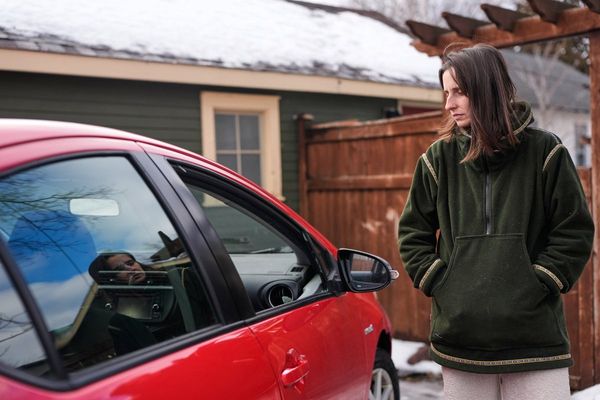
Sylvia Brady does not romanticise the state of her life as a newlywed in northern England in 1959.
“We’d get up in the morning and we’d go to work in the dark. We’d come home at night in the dark. It was always raining and there were these big posters everywhere: ‘Australia wants new migrants and it’s only 10 pounds.’”
So when her husband came home one evening and said “Let’s give Australia a go”, she didn’t bat an eyelid. She admits getting cold feet when the letter from Australia House arrived on Christmas Eve, giving them six weeks to pack up their life.
But her mother told her: “Go on, be off with you and find a better life than you’ve had here.”
Brady was among more than one million Britons who migrated to Australia under the Assisted Passage Migration Scheme between 1945 and 1982, known colloquially as “10-pound poms”.

Despite the British being the single-largest migrant intake in Australia for the entirety of that period, Alistair Thomson, a professor in history at Monash University, calls them “Australia’s invisible migrants” in comparison with what were at the time more politically controversial non-English-speaking migrants.
Their story is about to have a new light cast on it, when Ten Pound Poms hits streaming platforms on Sunday. The six-part drama series co-produced by the BBC and the Australian streaming service Stan depicts the gap between the life the migrants were promised and the reality of the conditions they found on arrival, set in 1956.
“Australia’s postwar reconstruction needed workers and more than anywhere else, they wanted to get them from Britain,” Thomson says.
The Australian government’s advertising of life in Australia presented an exciting prospect for British migrants, Thomson says, emphasising “how they’d be spending all their time on the beach, earning a fortune and owning their own house in no time”.
However, for Tom Riley, his family’s first 18 months spent in the cramped conditions of the Finsbury migrant hostel in Adelaide were a far cry from the posters depicting whitewashed houses and huge gardens.
The family’s next move to a Nissen hut (a semicircular corrugated iron prefabricated shelter) was slightly bigger but no cooler than the hostel and still had communal dining and washing facilities.
Riley remembers the tensions between the British and German migrants, many ex-soldiers. “It wasn’t very many years before when they were shooting at each other.”
Riley’s mother wanted to go back to England “straight away”.

His mother spoke of England as home right up until the end. “She hated it … she always spoke of England as home. She said, ‘I miss home’, even right up to the end.”
The experience, for many, Thomson says, was “not what they were dreaming of when they came to Australia”. The whinging pom stereotype emerged as Australians were quick to take offence at anything negative the British had to say about life in Australia not being as good as expected, he said.
The Australians perceived the British, with their assisted passage and supported living, as having a better deal than non-English-speaking migrant families, who not only needed to learn a new language but were separated, with the men required to work for the government for two years on schemes such as Snowy Hydro, Thomson says.
“Although they did have things to complain about.” The most difficult experience was for those working-class families who came out to Australia without much capital and became stuck in migrant hostels, paying for board at the same time as raising money to get out of them, Thomson says.
Whereas people who came out without dependents largely had a better time of it, Thomson says, because they were often single, more mobile and able enjoy themselves.

Many single people used the 10-pound assisted passage as “a bit like having a two-year working holiday. A lot of young people just thought ‘This is a great chance to see the world.’”
At 18 years of age, Barry Coaker, thought the navy would be his ticket out of England, leaving behind a family home half blown away in the blitz and the bad crowd he’d gotten mixed up with, who were stealing cigarettes and chocolates.
But the day he failed the navy’s medical exam, due to shortsightedness, his decision to take a different route back to the tube station took him past Australia House, whose leaflets promised a “sunnier future” for only 10 pounds.

Coaker, together with 20 other young British people, came out as part of the Big Brother movement on the P&O liner Strathaird, chaperoned by Australian journalist Craig McGregor.
The six-week voyage brought them past the Suez Canal and on to Egypt, Yemen, India and Ceylon (today Sri Lanka) before arriving in Sydney Harbour.
In Australia the adventure continued as Coaker picked grapes in Mildura, travelled on the back of an empty coal truck to Melbourne and slept in a field in Ouyen after being discovered in said coal truck.
Coaker remembers the migrant hostel was run by Australians who “didn’t particularly like English people. They were quite nasty actually.”
Coaker also says there was no advice offered to migrants about the differences between their home and Australia.
“I remember the first time me and three others from the hostel went to Bondi, we spent eight hours out in the sun. No sunscreen, bare tops. And the next morning, I had blisters hanging from my arms. They were like little balloons. It was terrible.”
Coaker had planned to return to England at the end of the two years he was required to stay in Australia – leaving any earlier would have meant paying the Australian government back the full fare. However, when he met his wife, Carol, he realised “I had a winner here, I’m not going home”.
The promise of better employment opportunities for women was true for Brady, who on receiving her first week’s wages from Mobil Oil told the paymaster she’d received a month’s wages instead of the fortnight. “He said ‘No deary, that’s your wages.’ I couldn’t believe it,” Brady said.
Brady said after the children came along and the family took their first trip back to the UK, 12 years after arriving was when she knew, “I just wanted to come home [to Australia]. I didn’t belong there any more.”
The chief content officer at Stan, Cailah Scobie, said the story of the 10-pound pom migrants was one which was “so relevant to so much of Australia and really hadn’t been seen on screen before”.

The producers wanted to ensure the story was told as authentically as possible and showed multiple points of view.
Aboriginal film-maker Ryan Griffen was brought on board early in the process to bolster the story, both from an Australian perspective but also from a First Nations’ perspective, Scobie said.
The co-production with the BBC came off the strong working relationship they developed as a result of TV series The Tourist, Scobie said. Both collaborations proved organic, “because at their heart, they told stories which are very prescient and relevant for British and Australian audiences”.
The Evening Standard’s review notes the show flips the usual script, making Britons the mistreated migrants “just as British [immigration] policy takes a turn for the worse”.
Thomson says: “I think that the lessons learned is whoever the migrants are that are coming to your country, you have to think hard about how to support them.
“Going to live on the other side of the world, away from all the things that you’re used to, even if the people are speaking the same language, even if they think they’re coming to Britain in the sun, it’s going to be both terribly strange, as well as awfully familiar.
“Anything to make it easier to make the extraordinary adjustment of going from one world to another, is a good investment.”
• In Australia, Ten Pound Poms premieres on Stan on Sunday 14 May. In the UK, it will be aired on BBC One and available on BBC iPlayer at 9pm on the same day.







